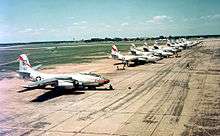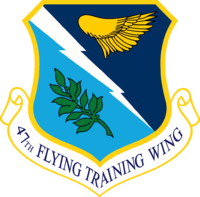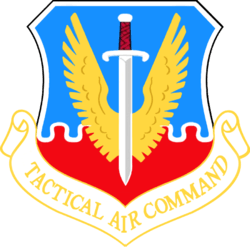47th Flying Training Wing
| 47th Flying Training Wing | |
|---|---|
|
47th Flying Training Wing Insignia | |
| Active | 15 January 1941 – present |
| Country | United States |
| Branch | United States Air Force |
| Role | Pilot Training |
| Size | Wing |
| Part of | Air Education & Training Command |
| Garrison/HQ | Laughlin Air Force Base |
| Decorations | Air Force Outstanding Unit Award |
| Commanders | |
| Notable commanders |
Donald G. Cook John W. Doucette |

The 47th Flying Training Wing (47 FTW) is a United States Air Force pilot training wing based at Laughlin Air Force Base, near Del Rio, Texas. It is one of five pilot training units in the Air Force's Air Education and Training Command which conducts joint specialized undergraduate pilot training for the United States Air Force, Air Force Reserve, Air National Guard and allied nation air forces utilizing the T-38C, T-6A and T-1A aircraft.
Units
- 47th Medical Group
- 47th Medical Operations Squadron
- 47th Medical Support Squadron
- 47th Mission Support Group
- 47th Security Forces Squadron "Amistad Defenders" Camp Bucca, 886th Expeditionary Security Forces Squadron
- 47th Operations Group (Tail Code: XL)
- 47th Operations Support Squadron
- 85th Flying Training Squadron (T-6A) "Tigers"
- 434th Fighter Training Squadron (T-6A) "Red Devils"
- 86th Flying Training Squadron (T-1A) "Rio Lobos"
- 87th Flying Training Squadron (T-38C) "Red Bulls"
- 340th Flying Training Group (AFRES)
- 96th Flying Training Squadron (T-38C, T-1A)
Aircraft flown
- T-41 Mescalero, 1972–1973
- T-37 Tweet, 1972–2004
- T-38 Talon, 1972–present
- T-1A Jayhawk, 1993–present
- T-6 Texan II, 2002–present
History
- See 47th Operations Group for additional history and lineage information prior to 1947
Cold War

Light bombardment operations in the United States
On 28 July 1947, the 47th Bombardment Wing was established as part of the Army Air Forces' implementation of the wing base reorganization, which combined tactical and support elements on its bases into a single wing. The wing became active on 15 August 1947 at Biggs Field, Texas, with the 47th Bombardment Group as its operational unit.[1] On 1 February 1948 Biggs was turned over to Strategic Air Command, forcing a relocation of the wing to Barksdale Air Force Base, Louisiana in November. In the fall of 1948 North American B-45 Tornado bombers began to be delivered to the wing, which became the first in the Air Force to fly the aircraft.[2] However, the B-45As were not truly operational, because they lacked both fire control and bombing equipment.[3]
The Air Force planned to equip five groups with the B-45, but in programming the units that would comprise its forty-eight group structure authorized in 1948, the number of light bombardment groups flying the B-45 was reduced to one. With this reduction, the Air Force decided to inactivate the 47th wing and transfer its B-45s to the 3d Bombardment Wing in Japan. However, the first B-45As delivered to the wing lacked sufficient range to ferry across the Pacific and they were too large to send on board available ships.[3] The additional high cost of maintaining its B-45 aircraft led the Air Force to inactivate the 47th on 2 October 1949.[1][3] However, the 84th and 85th squadrons of the 47th Bombardment Group kept their B-45s and moved to Langley Air Force Base, Virginia where they were attached to the 363d Tactical Reconnaissance Wing.[4][5][6]

On 12 March 1951, the 47th wing and group were reactivated at Langley, along with a number of support organizations to join the 84th and 85th Bombardment Squadrons.[8][9] The wing was assigned to Tactical Air Command (TAC).
European operations


After becoming proficient in the handling and use of nuclear weapons, moved to RAF Sculthorpe, United Kingdom where it began operations there on 1 June 1952. Operational squadrons of the wing were:
- 84th Bombardment Squadron (B-45A, B-66B) (17 November 1952 – 22 June 1962) (red tail stripe)
- 85th Bombardment Squadron (B-45A, B-66B) (17 November 1952 – 22 June 1962) (yellow tail stripe)
- 86th Bombardment Squadron (B-45A, B-66B) (23 March 1954 – 22 June 1962) (blue tail stripe)
For nearly three years, the 47th Wing provided an in-place Atomic Air Strike Force to back up NATO Ground Forces in Europe. In England, the wing was attached to the 49th Air Division of United States Air Forces Europe, but remained assigned to TAC. The wing provided combat crew training and operated USAF Air Crew School (Light Bombardment and Tactical Reconnaissance). Operational missions of the wing were training for tactical bombardment training operations, including participation in exercises and firepower demonstrations in support of NATO.
Owing to the size of Sculthorpe, the wing operated two B-45A jet bomber squadrons (84th and 85th) from Sculthorpe. In March 1954, a third B-45A jet bomber squadron (86th) was assigned to the wing, but operated from RAF Alconbury in order to accommodate the additional aircraft.
From May 1954 to December 1958, the 19th Tactical Reconnaissance Squadron was attached to the 47th Bomb Wing from the 363d Tactical Reconnaissance Wing. The 19th flew the reconnaissance version of the B-45 known as the RB-45C out of Alconbury. The RB-45s carried the same markings as the B-45, except for an added marking on the wingtip fuel tanks. This marking consisted of two stripes coming back off the top and bottom of the circular squadron emblem in the appropriate Squadron color near the outside front center of the tank. In 1958, the 19th began to re-equip with Douglas RB-66 Destroyers and its RB-45’s were transferred back to the United States. The RB-66B carried flash bombs in its bomb bay for night photography missions and was equipped with a battery of reconnaissance cameras. The RB-66B could also be fitted with a removable inflight refuelling probe attached to the right side of the forward fuse.
In October 1955, air-to-air refueling versions of the Boeing B-29 Superfortress bomber known as the KB-29P were added to the wing with the addition of the 420th Air Refueling Squadron from Alexandria Air Force Base, Louisiana, which operated out of Sculthorpe. In 1958 the KB-29s were upgraded to the jet-assisted KB-50Js which were specially equipped with two General Electric J47 turbojet engines that enabled the tankers to match the speed of the faster jet fighters during refueling
By 1957, carrying 10,000 personnel the 47th Bombardment Wing was the largest USAF organization in Europe with three bomber squadrons, one recon squadron and one air refueling squadron.
In early 1958, the re-equipment of the 47th Bombardment Wing began with more capable Douglas B-66B Destroyers replacing the B-45As. The wing's B-66s came from TAC's 17th Bombardment Wing, which was inactivating. The wing rapidly converted to the B-66, although operations were hampered through August by a series of maintenance difficulties.[10] By July 1958, the B-45s in the United Kingdom had all been transferred to other bases in Europe and North Africa, where they were used for fire-fighting training. Most were later junked and sold for scrap.[11]
On 10 January 1959, the 19th TRS was reassigned to the 10th Tactical Reconnaissance Wing at Spangdahlem Air Base West Germany.
On 1 July 1961, the 47th Bomb Wing was reassigned from Tactical Air Command to United States Air Forces Europe.
Inactivation

In 1962 Project Clearwater halted large scale bomber deployments to Britain with Sculthorpe, along with RAF Fairford, RAF Chelveston, and RAF Greenham Common, being turned over to the British Air Ministry. This resulted in the 47th Bomb Wing being inactivated on 22 June 1962.
A number of the B-66B bombers were reassigned to the USAFE 10th Tactical Reconnaissance Wing which stationed them to RAF Chelveston with the 42nd ECS. These aircraft were modified to the EB-66E electronic countermeasures configuration with the Electronic Counter-Measures tail system replacing the tail turret which was removed. Automatic jamming equipment was fitted in its place. Numerous antennae protruded from the aircraft, and chaff dispensing pods were carried.
With the wing's inactivation the 420th ARS at Sculthorpe was assigned to the 7375th Combat Support Group, a temporary unit at Sculthorpe after its turnover to the Air Ministry. On 1 September 1963 it was reassigned directly to Third Air Force. Problems, however, plagued he unit. With no new spares available cannibalization from the Davis-Monthan AFB boneyard was necessary to keep at least some of the retrofitted aircraft flying. Also many parts started to break simply because of old age. In addition, the tankers were simply too slow to refuel the faster tactical jet aircraft of USAFE. The 420th ARS was inactivated on 25 March 1964 at Sculthorpe when the KB-50Js were declared obsolete.
Pilot training
The 47th Flying Training Wing was reactivated and redesignated at Laughlin Air Force Base, Texas on 1 September 1972, replacing and absorbing the resources of the 3646th Pilot Training Wing. Since its reactivation, the wing has conducted undergraduate pilot training for USAF, Air Force Reserve, and friendly foreign nation air forces. Supported Accelerated Co-Pilot Enrichment Program at numerous locations, 1976–1986. Began airlifter-tanker track pilot training in 1994.
Lineage
- Designated as 47th Bombardment Wing, Light on 28 July 1947
- Organized on 15 August 1947
- Inactivated on 2 October 1949
- There is NO connection between this organization, and the WWII-era Fifteenth Air Force, 47th Bombardment Wing, inactivated on 15 October 1945, then redesignated 47th Air Division on 1 February 1951.
- Activated on 12 March 1951
- Redesignated 47th Bombardment Wing, Tactical on 1 October 1955
- Discontinued and inactivated on 22 June 1962
- Redesignated 47th Flying Training Wing on 22 March 1972
- Activated on 1 September 1972
Assignments
- Twelfth Air Force, 15 August 1947 – 2 October 1949
- Tactical Air Command, 12 March 1951 (attached to 49th Air Division l2 February 1952)
- Third Air Force, 5 June 1952 (remained attached to 49th Air Division to 1 July 1956)
- Seventeenth Air Force, 1 July 1961 – 22 June 1962
- Air Training Command, 1 September 1972
- Nineteenth Air Force, 1 July 1993 – present
Components
Wing
- 392d Bombardment Wing: attached 27 June 1949 – 2 October 1949
Groups
- 47th Bombardment Group (later 47th Operations Group): 15 August 1947 – 2 October 1949; 12 March 1951 - 8 February 1955; 15 December 1991 – present
- 4400th Combat Crew Training Group: attached 12 March 1951 – 12 February 1952
Squadrons
- 19th Tactical Reconnaissance Squadron: attached 7 May 1954 – 1 December 1956
- 39th Flying Training Squadron: 2 April 1990 – 15 December 1991
- 84th Bombardment Squadron: attached 17 November 1952 – 7 February 1955, assigned 8 February 1955 – 22 June 1962
- 84th Flying Training Squadron: 2 April 1990 – 15 December 1991
- 85th Bombardment Squadron (later 85th Flying Training Squadron): attached 17 November 1952 – 7 February 1955, assigned 8 February 1955 – 22 June 1962; assigned 1 September 1972 – 15 December 1991
- 86th Bombardment (later, 86th Flying Training) Squadron: attached 23 March 1954 – 7 February 1955, assigned 8 February 1955 – 22 June 1962; assigned 1 September 1972 – 15 December 1991
- 87th Flying Training Squadron: 2 April 1990 – 15 December 1991
- 420th Air Refueling Squadron: attached 15 March 1960 – 7 November 1961, assigned 8 November 1961 – 22 June 1962
- 422d Bombardment Squadron: attached 20 December 1953 – 23 March 1954.
Stations
- Biggs Field (later Biggs Air Force Base), Texas, 15 August 1947 – 19 November 1948
- Barksdale Air Force Base, Louisiana, 19 November 1948 – 2 October 1949
- Langley Air Force Base, Virginia, 12 March 1951 – 21 May 1952
- RAF Sculthorpe, England, 1 June 1952 – 22 June 1962
- Laughlin Air Force Base, Texas, 1 September 1972 – present
See also
References
Notes
- 1 2 Bailey, Carl E. (10 September 2008). "Factsheet 47 Flying Training Wing (AETC)". Air Force Historical Research Agency. Retrieved 19 May 2014.
- ↑ Knaack, p. 72
- 1 2 3 Knaack, pp. 74-75
- ↑ Maurer, Combat Squadrons. pp. 291-292
- ↑ Maurer, Combat Squadrons, pp. 294-295
- ↑ Ravenstein, pp. 191-194
- ↑ Identifiable aircraft are (nearest to farthest) 47-082, 47-089, 47-050, 47-061, 47-058, 47-081, 47-059, 47-064.
- ↑ Maurer, pp. 104-106
- ↑ Mueller, Robert (1989). Air Force Bases, Vol. I, Active Air Force Bases Within the United States of America on 17 September 1982 (PDF). Washington, DC: Office of Air Force History. p. 315. ISBN 0-912799-53-6.
- ↑ Knaack, pp. 435-436
- ↑ Knaack, p. 85
Bibliography
![]() This article incorporates public domain material from the Air Force Historical Research Agency website http://www.afhra.af.mil/.
This article incorporates public domain material from the Air Force Historical Research Agency website http://www.afhra.af.mil/.
- Endicott, Judy G., USAF Active Flying, Space, and Missile Squadrons as of 1 October 1995. Office of Air Force History
- Knaack, Marcelle Size (1988). Encyclopedia of US Air Force Aircraft and Missile Systems. Vol. 2, Post-World War II Bombers 1945-1973. Washington, DC: Office of Air Force History. p. 72. ISBN 0-912799-59-5.
- Maurer, Maurer, ed. (1983) [1961]. Air Force Combat Units of World War II (PDF) (reprint ed.). Washington, DC: Office of Air Force History. ISBN 0-912799-02-1. LCCN 61060979.
- Maurer, Maurer, ed. (1982) [1969]. Combat Squadrons of the Air Force, World War II (PDF) (reprint ed.). Washington, DC: Office of Air Force History. ISBN 0-405-12194-6. LCCN 70605402. OCLC 72556.
- Ravenstein, Charles A. Air Force Combat Wings, Lineage & Honors Histories 1947-1977 (PDF). Washington, DC: Office of Air Force History. ISBN 0-912799-12-9.
- Ravenstein, Charles A. (1984). Air Force Combat Wings, Lineage & Honors Histories 1947-1977 (PDF). Washington, DC: Office of Air Force History. ISBN 0-912799-12-9.
External links
- USAAS-USAAC-USAAF-USAF Aircraft Serial Numbers--1908 to present
- Joe Baugher's Encyclopedia Of Military Aircraft (A-20, A-26, B-45, B-66, KB-50)
- 420th Air Refueling Squadron
- Laughlin Air Force Base web site



